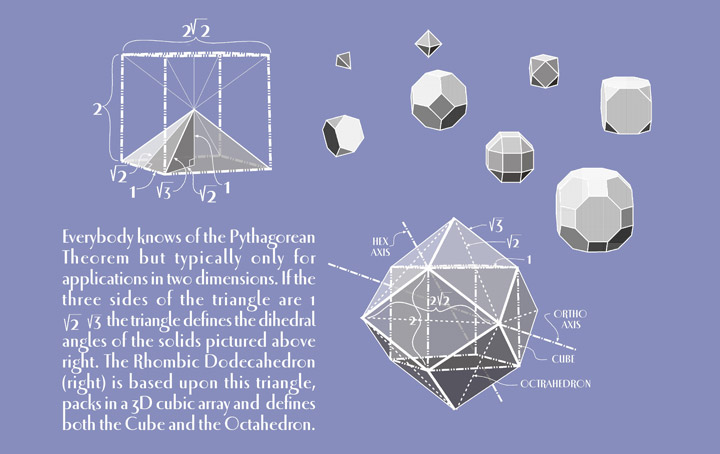
Taking Pythagoras into Three Dimensions
“a” squared plus “b” squared equals “c” squared The two most well known triangles that relate to this are: one(1) and one(1) and the square root of two one(1) and two(2) and the square root of three The first of these gives us a 45 45 90 triangle, the second gives us a 30 60 90 triangle. Both of these triangles are very useful to us in many ways and we will use them directly in the work following. But first, let’s look at another very important little triangle. Let’s call the edge length of the CUBE two. Then the edge length of the empty CUBES is also two. Let’s now draw diagonal lines in the empty CUBES, from each corner, through the center, and to the opposite corner. There will be only four of these lines in each CUBE as there are eight corners in a CUBE, but they will outline little pyramidal shapes on each of the six faces of the CUBES. These shapes are important to us. Now let’s find out the dimensions of these little pyramidal shapes. We know we already have a point in the center of the CUBE. This point is also the top of the little pyramid. We want to know the dimensions of a face of this pyramid. To do this we divide the face in half and use the Pythagorean Theorem. Remember, the bottom edge of this face is an edge of a two unit CUBE, so we have the first edge length (one) of our right angle triangle that is half of the pyramid face. And the length of the line from the center of the CUBE to the center of the edge (our dividing line) is the square root of two (one unit up, one unit in). So what is the dimension of the hypotenuse (the center of the CUBE to it’s corner)? You figure it out. Test in a week. If you take a CUBE and attach one of these little pyramids on each of it’s six faces you get something with twelve diamond faces called a “rhombic dodecahedron”. It has six four corner vertices and eight three corner vertices. I am thinking of calling it a rhombi-hedron or RHOMBICUBE, which do you think is better? This rhombi-whatever is not one of the Archimedean solids which have all vertices identical and are made with regular polygons. It is classed as a Catalan solid after the person who identified it in the late 1800’s. Why is this shape is important? Because it gives us an angle that plays a part in three dimensional geometry. More specifically, three dimensional geometry that relates to “cubic symmetry”. We throw out anything related to the pentagon. We keep in stuff related to the CUBE; of course the rhombi-hedron or whatever itself, the tetrahedron, truncated tetrahedron, the CUBE, truncated CUBE, octahedron, truncated octahedron, cubeoctahedron, small rhombicubeoctahedron, and the great rhombicubeoctahedron, plus some related prisms. What we get out of this is a family of polyhedra that interrelate in regular patterns in three dimensional space. This interrelation is reflected by the “dihedral angle” of the forms, the angle that defines the relationship of the adjacent planes of the surface polygons. Some of these angles are 120, 135, and/or 90 degrees, but the rest are all related to our new root triangle and the answer to the quiz. The length of the hypotenuse is the square root of three, and through trigonometry, we can find the angles to be approximately 35.25 and 54.75 degrees. So the form is a Rhombic Dodecahedron. The face angles are 109.5 (2 x 54.75)degrees and 70.5 (2 x 35.25) degrees. DIHEDRAL ANGLES Rhombic Dodecahedron 120 degrees Tetrahedron 70.5 (2 x 35.25) degrees Cube 90 degrees Octahedron 109.5 (2 x 54.75) degrees Truncated Tetrahedron 109.5, 70.5 degrees Cuboctahedron 125.25 (90 + 35.25) degrees Truncated Cube 125.25, 90 degrees Truncated Octahedron 125.25, 109.5 degrees Small Rhombicuboctahedron 144.75 (90 + 54.75), 135 degrees Great Rhombicuboctahedron 144.75, 125.25, 135 degrees |

